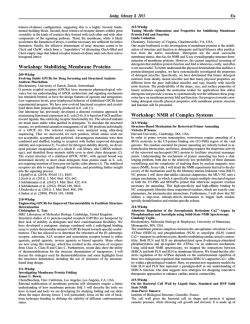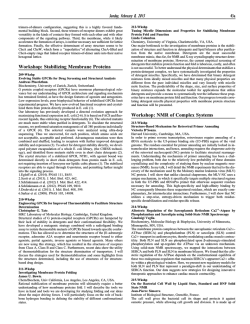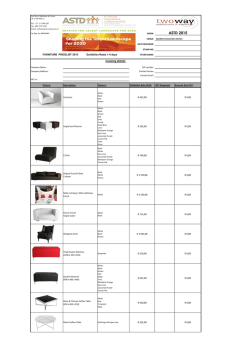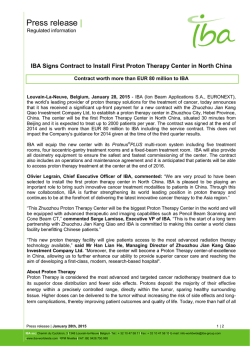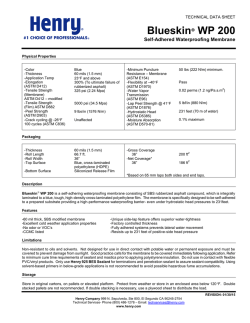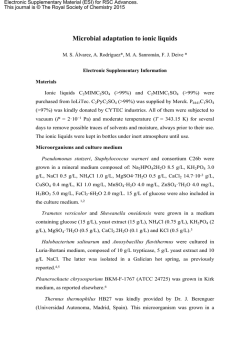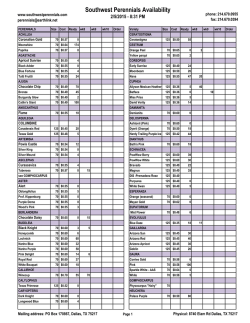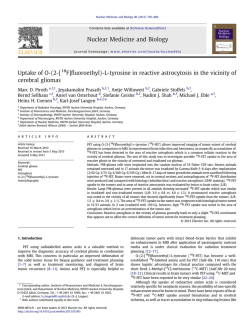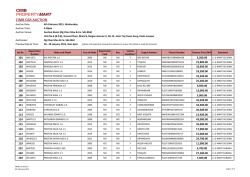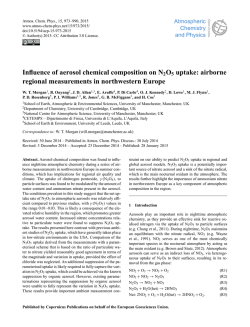
BRIEF COMMUNICATION
BRIEF COMMUNICATION ORDER OF PROTON UPTAKE AND RELEASE BY BACTERIORHODOPSIN AT LOW PH DRAKE MITCHELL AND G. W. RAYFIELD Physics Department, University ofOregon, Eugene, Oregon 97403 ABSTRACr The order of proton uptake and release in an aqueous suspension of purple membrane in response to a light flash has been investigated at lowered pH. pH indicator dyes and a flash spectrophotometer were used for the study. At pH 6.6 it was found that the release of protons from the purple membrane precedes uptake, as reported by other investigators. At pH 5.9, 4.9, and 4.1 it was also found that release precedes uptake. These results are not in agreement with those of previous investigators. INTRODUCTION Bacteriorhodopsin (bR) is a light activated proton pump that transports protons across the plasma membrane of Halobacterium halobium. This protein is found in large, ordered, two dimensional arrays known as purple membrane sheets. Recent reviews cover these and other aspects of bacteriorhodopsin in detail (1-4). When an aqueous suspension of purple membrane sheets is illuminated, a transient change in the pH of the bathing solution is observed. This uptake and release of protons into the bathing medium has been investigated in some detail. An optical method employing pH sensitive dyes (5-7), a volumetric technique (8), and a novel technique based on changes in the ohmic conductance of the bathing solution (9) have been employed for these studies. Near pH 7 it was found that protons are first released into the bathing solution from the photo-stimulated protein and then taken up (5-9) by it. However, at lowered pH (pH 4 to 5) single flash measurements have been reported in which the sequence is reversed, that is uptake precedes release (5, 9). Steady-state measurements at low pH using pH electrodes and an aqueous suspension of purple membrane sheets have been reported (10) that show alkalization of the bathing medium under illumination. This was interpreted as demonstrating that uptake of protons occurs more quickly than release at low pH. The retinal chromophore of bR is connected to a lysine residue of the opsin by a Schiff base, which is protonated in bR568 (11, 12). Studies have tested the notion that protonation of the Schiff base is correlated with the photoreaction cycle of the chromophore and with proton release and uptake from the bathing medium (6). In particular, detailed studies at pH 7 indicate that, in the M412 intermediate of the photoreaction cycle, the Schiff base is deprotonated (12, 13). Measurements of the K (11) and L BIOPHYS. J.©BiophysicalSociety Volume 49 February 1986 563-566 * (14) intermediates show that they are protonated, and M412 is therefore the first deprotonated intermediate (14). The formation of 0640, the principle intermediate in the M412 to bR568 conversion, has been kinetically associated with uptake of protons by bR (15), and at pH 7 it is found to be protonated (16). To our knowledge the protonation state of M412 intermediate has not been studied at low pH (pH 4 to 5). The decay of M412 has been correlated with the uptake of protons from the bathing solution (17, 7), and from pH 7 to 4.5 the time constant of this decay has been shown to increase (18). Over this pH range the time constant of M412 formation remains constant (19). If the sequence of release and uptake is reversed at lowered pH and the photoreaction cycle is essentially unaltered, then the correlation between the two becomes obscure. We have repeated measurements of the uptake and release sequence at low pH and find that release precedes uptake in agreement with the order of events near neutral pH. MATERIALS AND METHODS Bacteriorhodopsin in the form of purple membrane sheets was derived from strain JW 3 of Halobacterium halobium following the procedures of Becher and Cassim (20) with some minor modifications. Samples were stored in 40% sucrose (wt/wt) at 40C. Small aliquots were removed from this stock solution and used within 10 d. The sample was dialyzed for 24 h to remove sucrose. The flash spectrophotometer used for this investigation was constructed in our laboratory. The actinic light flash was provided by a flashlamp-pumped dye laser (model CMX-4; Chromatix Inc., Sunnyvale, CA) using rhodamine 590 dye and operating at a wavelength of 598 nm. The flash had a pulse width of 1 js and an energy of 3 to 4 mJ as measured by a calibrated bolometer (Scientech Instruments, Inc., Boulder, CO). A beam splitter in the laser beam sent a small fraction of the actinic beam to a PIN photodiode. The output of this photodiode was fed to the B channel of a Nicolet 4094 digital oscilloscope (Nicolet Instru- 0006-3495/86/02/563/04 $1.00 563 ment Corp., Madison, WI), and served as an external trigger. The amplitude of this signal was also used to monitor the laser intensity. The light source for the measuring beam was a quartz halogen lamp (I150 W). A stabilized, 24 V DC power supply was used for the lamp. The measuring beam passed through a high intensity, grating monochromator (Bausch & Lomb Inc., Rochester, NY) (1,200 grooves per millimeter) and was collimated by quartz lenses through the bottom third of a 1 x 1 cm quartz cuvette containing the sample. The volume of interaction between the two beams was maximized by using a quartz lens to spread the laser beam to approximately the size of the sample (1 x 1 cm). The measuring beam, after passing through the sample, was then focused by a quartz lens on a UV enhanced, inverted channel, PIN photodiode (UDT-UV005; United Technologies Corp., Hartford, CT). Appropriate interference filters were used to isolate the detector from the actinic laser flash. After amplification by an op-amp (OPACM 104 cm; Analog Devices Inc., Norwood, MA) in a current-to-voltage configuration, the signal from the photodiode was stored by the Nicolet oscilloscope. Signal averaging was used when it was found desirable to improve the signal to noise ratio. The proton uptake and release to the bathing medium of the photoactivated bR sample was monitored by using a pH indicator dye. To observe the time dependent absorbance change of the dye it was necessary to perform a difference measurement that removes the absorbance changes of the photocycling bacteriorhodopsin. This may be accomplished in either of two ways: (a) by comparing the absorbance changes of two samples with and without dye, or (b) by comparing two samples containing dye, with one containing an appropriate buffer. We chose the first method because of possible problems associated with an ionic strength effect on the photocycle kinetics (21). A second reason for not choosing the buffer method was a recent observation of a flash induced absorbance change due to proton release in a buffered solution of purple membrane and p-nitro-phenol (22). The data was transferred from the Nicolet 4094 (Nicolet Instrument Corp.) to an IBM PC (IBM Instruments, Inc., Danbury, CT) for further analysis. Along with the flash-induced kinetic absorbance data we included the voltages corresponding to the absolute baseline and the magnitude of the laser flash intensity in each computer data file. The absolute base line was used to calculate the absolute absorbance change from the observed intensity change. This is a necessary step for comparing changes in two separate samples with different initial absorbances. Both traces were normalized to the same actinic flash intensity. Following these procedures a computer program performed the appropriate subtraction and plotted the absorbance change of the dye. The pH indicating dyes used in this study were either those used by other investigators (p-nitrophenol, bromocresol green) (5-7) or were selected according to a modified protocol of Lozier (21). The final choice of a dye had to satisfy several experimental considerations: (a) The dye should be soluble in water and have little affinity for the purple membrane. (b) The dye should not affect the photocycle kinetics of the bacteriorhodopsin. (c) The absorbance of the dye must be sensitive to changes in pH at the pH of interest. (d) The dye should show little or no absorption at the actinic wavelength (598 nm). This last requirement is essential if one is to compare samples with and without dye. P-nitrophenol was satisfactory near pH 6.6 and pH 5.9. A search of other pH indicating dyes showed that 2-5 dinitrophenol is suitable for measurements near pH 5 while 2-4 dinitrophenol can be used near pH 4. The static absorption spectra of these dyes at different pH were obtained using a Hewlett-Packard spectrophotometer (model no. 8450 UV/vis). No dye was detected when a pellet of bR from a dye-bR sample was resuspended in distilled water. The static absorption spectra of the dyes was unchanged in the presense of bR. The time-dependent absorption at 660 nm of light-activated bR was unaffected by the presence of any of the three nitrophenol pH indicator dyes. Bacteriorhodopsin has significant buffering capacity in the full pH range of interest. This buffering effect was taken into account by measuring the change in static absorbance of a mixture of purple membrane and dye as a function of H+ added. The buffering capacity of 564 the purple membrane alone was also measured independently, using a pH electrode and titrating against HCI. Table I shows the type of indicator dye used for each pH along with the dye concentration and measuring wavelength for each sample. All measurements were made at a bR concentration of 3 IAM in 250 mM KC1. This salt concentration was used to maximize proton pump activity (7, 8). All measurements were carried out at room temperature, 19-210C. RESULTS A typical set of time dependent absorption curves used to determine the proton concentration in the bathing medium after a light flash is shown in Fig. 1 for 2-5 dinitrophenol at pH 4.9. Curve 1 a (without dye) is subtracted from curve 1 b (with dye) to yield AA, the dye response. AA is linearly related to the number of protons released to the bathing medium when the buffering of the bR sample is taken into account (see Methods above). AA can be converted to ApH which measures the number of free protons in solution not the number released to solution. AA/ApH in Fig. 1 is 0.51. Fig. 2 shows a similar set of absorption curves taken with and without 2-4 dinitrophenol at pH 4.1. The dye response is shown in Fig. 2 c and is consistent with release preceding uptake at pH 4.1. The results shown in Figs. 1 and 2 contradict the order of uptake and release reported by Dencher and Wilms at pH 5 (5) as well as the results reported by Marinetti and Mauzerall at pH 4.2 (9). Further studies at pH 5.9 and pH 6.6 using the indicator dye p-nitrophenol were consistent with results reported by Lozier et al. at pH 6.5 (6) and Govindjee et al. at pH 6.6 (7), which showed that release precedes uptake. An attempt was made to repeat the results of Dencher and Wilms using bromocresol green. The high absorbance of this dye at the actinic wave-length (OD = 0.7 at 598 nm for a 4 ,uM solution at pH 5) means that the two samples to be compared must both contain dye, and one must be buffered. Dencher and Wilms used 6 ,uM bR and 46 ,M bromocresol green in distilled water as the sample, and the same concentrations of dye and bR in 98 mM citric acid/phosphate buffer as the control, both at pH 5. It was necessary to reduce the dye concentration to 4 ,uM since 46 ,uM bromocresol green has an OD of -10 at 620 nm and pH 5, which was too high for our system. We found that the buffer had a significant effect on the bR photocycle at 620 nm. This was found to be consistent with an observed ionic strength effect on the photocycle (unpublished results). To negate the ionic strength effect an experiment TABLE I Dye concentration Measuring wavelength p-nitrophenol bromocresol green 170,uM 400 nm 3 ,M 2-5 dinitrophenol 2-4 dinitrophenol 190,uM 70MM 620 nm 435 nm 400 nm pH Dye 5.90 5.00 4.90 4.10 BIOPHYSICAL JOURNAL VOLUME 49 1986 was performed using 4 ,M bromocresol green in a solution of 3 MM bR and 250 mM KCl for both the sample and control. The control was buffered at pH 5.0 by 10 mM malic acid. Measurements at 620 nm on this pair yielded a dye signal that showed release of protons occurring first, in agreement with our other measurements. CONCLUSIONS 0 1~~~~A Ib d LOG TIM-E.( acid FIGURE 1 The flash-induced absorbance change of bacteriorhodopsin (a) bR without pH indicator dye. (b) bR in the presence of 190 AiM 2-5 dinitrophenol. (c) b-a, the flash-induced absorbance change of 2-5 dinitrophenol. The curves (a, b) are the average of 100 flashes, 5 s apart. Both of the solutions contained 3gM bR and 250 mM KCl with the pH adjusted to 4.90 using HCl. The first 148 jis of the traces are obscured by the photodiode's recovery from the laser flash. at 435 nm is shown: - 6: :;' 8J 0.148uM.s X _ e/cd1, lonis lO4iinslO s b 6 _ ;.LOG TIME 4&s) besef 0 O j. . . . . . .. .. d FIGURE 2 The flash-induced absorbance change of bacteriorhodopsin at 400 nm is shown: (a) bR without pH indicator dye. (b) bR in the presence of 70 jIM 2-4 dinitrophenol. (c) b-a, the flash-induced absorbance change of 2-4 dinitrophenol. The pH of both solutions was 4.10. The solutions contained 3 AM bR and 250mM KCI. The curves (a, b) are the average of 32 flashes, 5 s apart. MITCHELL AND RAYFIELD Order of Proton Uptake and Release We find that the order of uptake and release is not reversed when the pH is lowered to pH 4.9 or pH 4.1. We suspect that our results differ from those of Dencher and Wilms because they did not take into account the effect of ionic strength on the photocycle. When the ionic strength of the sample and control were balanced, bromocresol green gave results at pH 5.0 consistent with release preceding uptake. Lozier (21) has criticized the photoconductivity measurements for determining proton release and uptake by purple membrane sheets in an aqueous solution on the basis that the results can be complicated by motions of charges other than protons. Marinetti and Mauzerall (9) seem to have taken this into account by varying the buffer concentrations. We do not know why our results differ from those of the photoconductivity measurements. This work was supported by National Institutes of Health grant GM 26669. Received for publication 30 May 1985 and in final form 17 September 1985. REFERENCES 1. Eisenbach, M., and S. R. Caplan. 1979. The light-driven proton pump of Halobacterium halobium: mechanism and function. Curr. Top. Membr. Transp. 12:165-248. 2. Stoeckenius, W., R. H. Lozier, and R. A. Bogomolni. 1979. Bacteriorhodopsin and the purple membrane of halobacteria. Biochim. Biophys. Acta. 505:215-278. 3. Stoeckenius, W., and R. A. Bogomolni. 1982. Bacteriorhodopsin and related pigments of halobacteria. Annu. Rev. Biochem. 52:587616. 4. Honig, B. 1982. Theoretical aspects of photoisomerization in visual pigments and bacteriorhodopsin. In Biol. Events Probed by Ultrafast Laser Spectroscopy. 281-297. 5. Dencher, N., and M. Wilms. 1975. Flash photometric experiments on the photochemical cycle of bacteriorhodopsin. Biophys. Struct. Mech. 1:259-271. 6. Lozier, R. H., W. Niederberger, R. A. Bogomolni, S.-B. Hwang, and W. Stoeckenius. 1976. Kinetics and stoichiometry of light-induced proton release and uptake from purple membrane fragments, Halobacterium halobium cell envelopes, and phospholipid vesicles containing oriented purple membrane. Biochim. Biophys. Acta. 440:545-556. 7. Govindjee, R., T. G. Ebrey, and A. R. Crofts. 1980. The quantum efficiency of proton pumping by the purple membrane of Halo- bacterium halobium. Biophys. J. 30:231-242. 8. Ort, D. R., and W. W. Parson. 1979. The quantum yield of flash-induced proton release by bacteriorhodopsin-containing fragments. Biophys. J. 25:341-354. 9. Marinetti, T., and D. Mauzerall. 1983. Absolute quantum yields and proof of proton and nonproton transient release and uptake in 565 10. 11. 12. 13. 14. 15. 16. 566 photoexcited bacteriorhodopsin. Proc. Natl. Acad. Sci. USA. 800:178-180. Garty, H., G. Klemperer, M. Eisenbach, and S. R. Caplan. 1977. The direction of light-induced pH changes in purple membrane suspensions. FEBS (Fed. Eur. Biochem. Soc.) Lett. 81:238-242. Rothschild, K. J., and H. Marrero. 1982. Infrared evidence that the Schiff base of bacteriorhodopsin is protonated: bR 570 and K intermediates. Proc. Natl. Acad. Sci. USA. 79:4045-4049. Aton, B., A. G. Doukas, R. H. Callendar, B. Becher, and T. G. Ebrey. 1977. Resonance Raman studies of the purple membrane. Biochemistry. 16:2995-2999. Lewis, A., J. Spoonhower, R. A. Bogomolni, R. H. Lozier, and W. Stoeckenius. 1974. Tunable laser resonance Raman spectroscopy of bacteriorhodopsin. Proc. Natl. Acad. Sci. USA. 71:44624466. Argade, P. V., and K. J. Rothschild. 1983. Quantitative analysis of resonance Raman spectra of purple membrane from Halobacterium halobium: L550 intermediate. 1983. Biochemistry. 22:34603466. Lozier, R. H., R. A. Bogomolni, and W. Stoeckenius. 1975. Bacteriorhodopsin: a light-driven proton pump in Halobacterium halobium. Biophys. J. 15:955-964. Smith, S. O., J. A. Pardoen, P. P. J. Mulder, B. Curry, J. Lugtenburg, and R. Mathies. 1983. Chromophore structure in 17. 18. 19. 20. 21. 22. bacteriorhodopsin's 0640 intermediate. Biochemistry. 22:61416148. Lozier, R. H., W. Niederberger, R. A. Bogomolni, S.-B. Hwang, and W. Stoeckenius. 1976. Kinetics and stoichiometry of light-induced proton release and uptake from purple membrane fragments, Halobacterium halobium cell envelopes, and phospholipid vesicles containing oriented purple membranes. Biochim. Biophys. Acta. 440:545-556. Li, Q.-Q., R. Govindjee, and T. G. Ebrey. 1984. A correlation between proton pumping and the bacteriorhodopsin photocycle. Proc. Natl. Acad. Sci. USA. 81:7079-7082. Lam, E., and L. Packer. 1983. Nonionic detergent effects on spectroscopic characteristics and the photocycle of bacteriorhodopsin in purple membranes. Arch. Biochem. Biophys. 221:557564. Becher, B. M., and Y. Cassim. 1975. Improved isolation procedures for the purple membrane of Halobacterium halobium. Prep. Biochem. 5:161-178. Lozier, R. H. 1982. Rapid kinetic optical absorption spectroscopy of bacteriorhodopsin photocyles. Methods Enzymol. 88:133-162. Drachev, L. A., A. D. Kaulen, and V. P. Skulachev. 1984. Correlation of photochemical cycle, H' release and uptake, and electric events in bacteriorhodopsin. FEBS (Fed. Eur. Biochem. Soc.) Lett. 178:331-335. BIOPHYSICAL JOURNAL VOLUME 49 1986
© Copyright 2025
